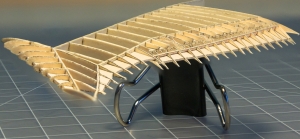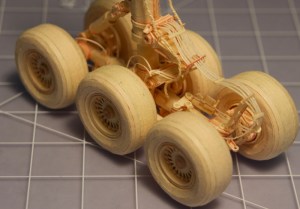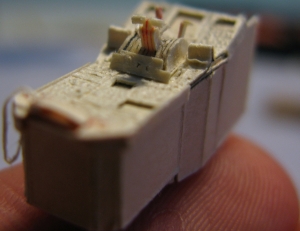The closer you look the more you will be in awe of this shockingly intricate 777 replica. The fully-articulating landing gear alone has over 2,000 parts and 200 hours of assembly, not even including the penny-sized tires with individually-cut lug nuts. All carved from manilla office folders by hand.
 A high school
A high school art architecture class in 2008 inspired this build by teaching a few papercrafting techniques. When [Luca] got a hold of a precision Air India 777-300ER schematic, he started building this 5 foot long 1:60 scale model. His project has received a fair amount of media attention over the years, including some false reports that he was so focused on the build that he dropped out of college (he did, for 2 years, but for other reasons). 6.5 years in the making, [Luca] is rounding the homestretch.
 The design is manually drawn in Illustrator from the schematics, then is printed directly onto the manilla folders. Wielding an X-acto knife like a watch-maker, [Luca] cuts all the segments out and places them with whispers of glue. Pistons. Axles. Clamps. Tie rods. Brackets. Even pneumatic hoses – fractions of a toothpick thin – are run to their proper locations. A mesh behind the engine was latticed manually from of hundreds of strands. If that was not enough, it all moves and works exactly as it does on the real thing.
The design is manually drawn in Illustrator from the schematics, then is printed directly onto the manilla folders. Wielding an X-acto knife like a watch-maker, [Luca] cuts all the segments out and places them with whispers of glue. Pistons. Axles. Clamps. Tie rods. Brackets. Even pneumatic hoses – fractions of a toothpick thin – are run to their proper locations. A mesh behind the engine was latticed manually from of hundreds of strands. If that was not enough, it all moves and works exactly as it does on the real thing.
Tires actually swing and steer. Landing gear actually collapses and folds up. The flaps move. The engines are not just magnificent static replicas; the 777 has a collapsible rear section for reverse thrust and so does [Luca]’s manilla version. The cabin and cargo doors hinge and lock into place. Even the bathrooms are just as cramped as you remember them being.
[Luca] spent a whole summer just on the furniture: the 300+ economy seats took him 20 minutes each, two business class seats could be finished in a day, and a single first class suite was a full 8 hour shift. The engines took another five months. The galley too has plenty of detail – row after row of carts and cabinets.
 It is not just the precision, meticulousness, and detail that impresses – the infinitesimal scale defies belief. The individual cockpit controls are each dwarfed by the grooves of their maker’s fingerprints. See the video embedded below of the main landing gear retracting and note the whole assemblies manipulated by tweezers. Just like the real thing the gear is small but strong, it can support several times the weight of the finished jet.
It is not just the precision, meticulousness, and detail that impresses – the infinitesimal scale defies belief. The individual cockpit controls are each dwarfed by the grooves of their maker’s fingerprints. See the video embedded below of the main landing gear retracting and note the whole assemblies manipulated by tweezers. Just like the real thing the gear is small but strong, it can support several times the weight of the finished jet.
Expecting to be complete later this year (though he said the same thing last year), [Luca] has already started painting the fuselage. After he is done he plans to one-up himself with a 20 foot version.
[Luca] does not have a project page per se but he documents well. He even spent two weeks editing 130 hours of time-lapse footage for his fans to appreciate the work that goes into a single assembly. For all the glorious details see his Flickr albums or his Youtube channel.
Thanks [Lars] for the tip.
* Corrected, it was an architecture class, not an art class.















This is awesome.
I can’t think of a word that describes this. Maybe “insane”.
I wonder how long the paper and glue will last through oxidation and humidity? If I were him, I’d seal it in a glass case coated with UV protectant and filled with nitrogen.
A museum likely will. But you’re seriously over thinking it there.
A room with non-UV lights (no fluorescent lights, probably no LED’s either. old school incandescent bulbs as a rule). That leaves oxidation which isn’t as big a problem as you think. If he used archival safe manila folders, that takes care of a big portion of the degradation right there. Same goes for whatever glues he opted to use.
I forget what the humidity and temperature is supposed to be for paper, but it isn’t “bone dry”. It’s easily looked up but is well within the realm of human comfort, if a bit chilly.
If he didn’t have so many progress photos, I’d have called hoax. The size and detail is mind boggling!
If [Luca] isn’t the world’s best papercrafter, I’d love to see who is.
I can’t even call it papercraft. The difference between mere papercraft and what [Luca] has done, is…well, like this Penny-Arcade strip. http://penny-arcade.com/comic/2010/08/20
btw, this was inspired by a very demanding high school architecture class. i would hesitate to call it “art class.”
Only reference I recall was that he learned paper-folding techniques in the class. Bad assumption. There’s no writeup for the project, just hundreds of photos and hours of video footage. The link you posted below is 404’d, I’ll take your word on it and squeeze a correction in. Thanks.
*bows*
reference for “architecture class” here. enjoy.
http://blog.flickr.net/en/2014/09/02/from-manila-folders-to-boeing-777-300er/
Hat of to you sir!
Simply amazing in every conceivable way. I’m completely blown away by this.
Some insider info:
At Hackaday we try to avoid using weasel words in the headline. It’s a slippery slope and while in the short term yields more click-throughs, it’s overly sensationalist and exhausting to the readers for everything to be pumped up that way. If you abuse it, then “Extreme” becomes “Meh”, just sets a false base level.
I had yet to say anything like that until this article. My original headline started as “Mindblowing Boeing 777….” because I felt there was no other way to describe it. I spent hours and hours writing this because I kept getting distracted, zooming way in and staring at the images.
My editor snipped that first word from the headline, presumably to make it less sensationalist. Probably justifiable, but, I’m with you, it’s not salesmanship, I genuinely felt that jubilant.
Matt, you are completely correct. I think the editor may have made a mistake in this case. “Mindblowing”, in this case, is neither hyperbole nor sensationalist. It’s a very good adjective that can be used accurately in very few other instances.
Naw, it’s slippery slope. How I feel, and what makes an appropriate headline are separate things.
I appreciate that you’re injecting some sensibility into the process. The internet seems to be getting worse with the click-bait tendencies, and it’s getting to be annoying.
‘Mindblowing’ indeed. Casters on the meal carts in the galley? The fully articulated hatches with all the little latch details? The crew rest module? …nevermind the whole ridiculous landing gear assembly… It makes my brain ACTUALLY hurt just trying to understand how someone could do this with file folders, basically from their own patterns…
The fact that he goes in and somehow embosses details in the surfaces, considering the scale, I can’t even imagine. Though that’s not saying much, since I can barely imagine assembling anything much smaller than the smallest fuselage parts… (I’ve always been kind of terribad with models.)
I’m glad to see ya’ll aren’t trying to clickbait us. I’ve made a habit of boycotting all that crap since it’s always a scam.
Beautiful work!
Damn, this is some kind of idiot savant level of amazing, if Boeing doesn’t hire this guy Airbus should!
[Luca] has created a legendary artifact!
holy mother of paper airplanes…
Luca, could you file these for me?
Thanks for today’s belly laugh!
It belongs in a museum for all to gaze upon.
The Visionary Arts Museum in Baltimore, MD USA would be a good candidate. They have tons of art by “outsider” artists from prisons, mental institutions, folk artists, and just plain obsessive people (like this project).
Surely this has been made by somebody well past the age of six and then some….
Words cannot describe the insanity of this thing. The eyes of mere mortals like us are not worthy to gaze upon it. This seriously might just be the most intricate hand crafted thing I have ever seen.
No words exist to describe the awesomeness of this…. HOLY S#!T this is some super human skill.
Amazed is an understatement.
Luca: please, please stick this model in a helium-filled glass box! Maybe an upside-down aquarium would be the best solution.
I believe argon is now used, not helium.
I’ve seen some of this project before, and it’s even more impressive. If i were doing it, I’d probably draw it on a computer for cutting on a laser engraver, but still get frustrated because that’s a lot of work.
THIS GUY DID DRAW IT ON A COMPUTER FIRST.
The real issue is he cuts out the pieces with an exacto knife, then carefully glues them together. Have not looked at the archive pictures, but I assume he uses a microscope or other magnifier image enhancer..
this will be the first time i say the next phrase.
this is not a hack.
this is insanity.
Yeah, not a hack and not even our typical computer or electronic related.
The nearest thing it is to a hack, is the unconventional use of manilla office folders as a construction medium.
And yet, I’ve not heard a peep that it doesn’t belong here. This project is a celebration of engineering and I think all our readers appreciated seeing it.
I was wishy-washy on whether to just enjoy it for myself or to write an article. I’m glad I did.
i for one look forward to future projects like this.
i’m still going through the images, and am still getting blown away.. the amount of detail that went into this is just incredible.
Awesome build.
BUT
From wikipedia:
“Manilla”, Common erroneous spelling of Manila, capital of the Philippines.
It’s such a common “misspelling”, including all manner of journals, published novels, etc. that it’s included as an acceptable alternate spelling in some dictionaries. Though, had I noticed I would’ve used the more common betterer spellin’s. I will plant my feet firmly and not let the uneducated take my literal “literally” away from me, regardless of how commonly abused and now accepted it is to mean the opposite.
That, and manilla it slips under the spellcheck radar by also being a form of West African currency. Sneaky.
That, plus it rhymes with vanilla.
I am bogged. I don’t care if this is a “hack” by the normal standards.
I look at this and have to think this not OCD – it is CDO – “get it in alphabetical order!”. I suspect [Luca] will become a case study in psych classes.
I can’t help being impressed by the detailed work that want into this, and yet at the same time thinking how the time could have been used for something else. The problem for me is I have never understood the desire to do artistic things like painting, cross stitching and model making as the end result is something that looks nice but has no useful function and clutters the place up.
It is probably just the way a lot of engineer type brains are wired, wanting something to have a purpose other than just purely aesthetic. I can’t for example begin to fathom why people buy pottery ornaments to put on display in their house, they are the sort of thing that I would throw straight in the trash for having no useful function.
You have to remember what most people use most of their spare time for. Its a good chance things like this are built instead of watching TV (or surfing buzzfeed or something). The hour I spent last night fixing an old desk fan (worth $10 or so) didn’t take time from doing something more important, it took time from surfing reddit.
I’m an engineer as well, but I do engineering for art from time to time (pc demo’s for demo competitions).
Either way, that landing gear is very beautiful, even without the plane.
Think about everything he learned while making this.
It takes a lot to understand something in theory.
It takes a lot more to be able to make it a reality.
My thought exactly. He must have learned a lot, while sometimes getting stuck and sometimes having those euphoric “Eureka!” moments. It is a beautiful process.
One of the biggest joys in my life the last years is to see people learn new things and impress with what they do with their acquired knowledge and skills, even when the tools sometimes can be crude (a free open source flight simulator, FlightGear).
Somehow “Randy Pausch last lecture” seems related to the experience.
John Lennon:
“The time you enjoy wasting, was not wasted.”
some people build things with no actual purpose, and some build with a purpose to fulfill a need or desire. i fly helicopters into the ground and blow up electronics that are technically over my head. but i enjoy doing it.
The only way to out do this build would be to run wires, cables, and pressure lines throughout the plain and make the controls actually work, I try to think about that and my brain kind of goes, tick tick tick tick, thunk and I get a 404 error.
The world NEEDS people like this. Unbelievable!
UNWORTHY! WE ARE UNWORTHY!
Painstakingly Awesome !!
HAD spell check is not functional mmmm!
It’s “Manila ” not Manilla !
If I was filthy rich, I know what I would spend 1 million Dollars on…
This plane and a commission on the next model…
I feel like Boeing should give this model its own serial number.
And buy it from him, and display it in the lobby of their headquarters.
It’d probably be better for it to be placed in Boeing’s Air and Space Museum in Seattle and make it part of their 777 exhibit. Primarily since they have the technology and resources to properly preserve it (Perhaps seal it in a glass case made from the windshield of a 777 since it has UV-blocking properties)
On another note, where did he get the schematics?
Amen to both ideas.
Talk about wrecking the curve, imagine him showing up at your paper airplane contest!
This is a staggering effort. I hope there is a lucrative spot in the world for him.
[Luca} don’t let my daughter touch this, she WILL try to see how it flies!
Honestly, I am not impressed. He is drawing the parts in CAD using real schematics, and the printing them out on his printer. He then just cuts the parts out and glues them. Anyone can do this. The only thing he is really showing off is his tenacity for wasting time.
No, he primarily figures out how to print out three-dimensional parts as one-dimensional strips of card stock so that they can be assembled to accurately — very accurately — represent those 3D parts once assembled, AND work mechanically. That is an epic engineering feat. Not to mention that wielding an Xacto blade with such accuracy is worthy of respect in itself.
This appears to be some very nice craftsmanship but how did he happen to bet his hands on a actual Boeing schematic?
What does his girlfriend think of this I wonder, she must be very proud. WHAT! NO GIRLFRIEND?
Probably doesn’t even have time for SpanktaVision….
it’s all fun and games til you get icing on your empennage…
Excuse me, but… PAINTING? He is PAINTING this beautiful thing? Say it isn’t so!
Don’t you worry, it ain’t ruined ;)
https://www.youtube.com/watch?v=g7R2ldqDxnA
Thanks everyone for the incredibly kind comments, I kinda randomly stumbled across this article and it makes me so happy to see the enthusiastic responses!
Hey Luca – I tried to track you down to let you know I’d written an article, but couldn’t find contact info. Glad you found us.
For what it’s worth, you should be even more impressed that everyone’s been supportive. Of the tens of thousands of people that’ve read this article, you’d know damn sure if anyone would’ve had anything negative to say they would’ve run in here and shit all over it like they usually do. It’s really a testament to your project that everyone’s too stupefied to even be critical.
Congrats on the build and best of luck finishing it sometime this year.
Thanks! And sorry about the difficulty in getting ahold of me.
I get lots of reactions and feedback—both positive and negative—and I understand both sides of the spectrum. It’s a weird enough project that some channel their bemusement into insults (which more often than not just crack me up) while others are incredibly ecstatic and effusive.
Thanks again for the really nice write-up, and I’ll (obviously) be posting updates to my flickr/yt as I trudge toward the finish line.
Wow!
Without a doubt one of the coolest things I have ever had the pleasure to watch.